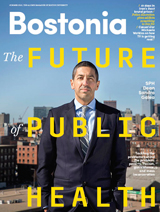During his election campaign, Donald Trump barely mentioned science, and what he did have to say about it—that climate change is a hoax, that he’d heard a lot about the National Institutes of Health (NIH) and it was terrible—was hardly encouraging to scientists. But despite low expectations, Trump’s 2018 budget blueprint, released last week, with sweeping cuts to medical research and public health programs (including $5.8 billion, or 18 percent, from the NIH), stunned researchers at Boston University and at research institutions across the country.
“The NIH cuts were what really caught people by surprise,” says Gloria Waters, vice president and associate provost for research. “Republicans have typically increased funding for the NIH. There was a lot of talk about how the NIH might even go up, as funding for other areas goes down, or ceases to exist. Funding for health research is typically a nonpartisan issue that all agree the government has got to be behind.”
“Like most scientists, I am terrified by the proposal,” says Neil Ganem, a School of Medicine assistant professor of pharmacology and experimental therapeutics, whose research in understanding how cells become cancerous opens up new avenues for treating cancer. A cut of nearly 20 percent to the NIH would be catastrophic, says Ganem.
“There would be fewer scientific breakthroughs, fewer clinical trials, less drug development. Citizens would suffer.”
However, he adds, he remains optimistic. “I truly believe that Congress will never let this budget proposal pass,” he says. “I think this budget will get blasted by many smart, responsible, and socially conscious politicians who understand the real value of science.”
Waters, and Jennifer Grodsky, vice president for federal relations, who closely tracks Congressional support for research funding as part of her job in advocating for BU faculty in Washington, agree that Ganem has a reason to be optimistic. “These cuts are unlikely to be enacted wholesale by Congress,” Grodsky wrote to administrators and faculty last week. “This is merely the first step in this year’s budget negotiations.”
“I truly believe that Congress will never let this budget proposal pass. I think this budget will get blasted by many smart, responsible, and socially conscious politicians who understand the real value of science.” —Neil Ganem
Trump’s budget blueprint is scant on details—it mentions no specific plans for the National Science Foundation (NSF), for example—and a more detailed proposal may be released as early as May, Grodsky says. (This budget, for fiscal year 2018, is separate from the current fiscal year 2017 budget, which remains in limbo until Congress completes work on its spending bills this spring.) There is strong bipartisan Congressional support for the NIH and medical research, she says, and it is unlikely that Trump’s deep cuts in those areas—part of the administration’s strategy for offsetting its proposed $54 billion increase in defense spending and paying to build a wall along the US-Mexico border—will be enacted.
Grodsky also believes that Trump’s proposed cuts to programs designed to make college more affordable, programs that have bipartisan support, are unlikely to come to fruition. The Trump blueprint eliminates Supplemental Educational Opportunity Grants for low-income students, reduces the Federal Work-Study program significantly, and rescinds the $3.8 billion Pell Grant surplus. “Every Congressional office I visit puts college affordability and helping students at the top of their priority list,” says Grodsky. “I think legislators will reject any proposal that takes away resources for students in need.”
The funding priorities outlined in Trump’s budget could have“direct impact on some of this country’s neediest college students,” says Christine McGuire, vice president ad interim for enrollment and student affairs, adding that BU students receive federal Pell Grants, Federal Supplemental Educational Opportunity Grants (commonly known as SEOG), and Federal Work-Study. “It is very early in the federal budget process,” she says. “But the University is concerned and is doing everything possible to mitigate the potential impact to our students.”
In fiscal year 2016, BU bucked the national trend of declining academic research funding and attracted $368.9 million in new research funding, an overall increase of 13 percent over the previous year. The federal government provided roughly $300 million—or nearly 82 percent—of that funding, with the biggest chunk coming from the NIH, which awarded BU faculty more than $200 million in grants, more than two thirds of the overall money.
“The thing we’ve said over and over is that the federal government is the largest funder of science,” Waters says. “Its not like there is anything in the wings that is going to replace that. Some people think industry can play a role, and we’re trying to increase our relationships with industry, but there is no way that is going to replace funding from the federal government. Some people think the University can pay for research, but we don’t have the funds to replace the money the federal government has put into research.”

Sabrina Reilly (CAS’19) (left) and Robert Reidy (CAS’19) using fluorescence microscopy to examine mouse brain slides in an Integrated Science Experience lab, run by CAS instructor Brad DiBenedictis, that joins organic chemistry and cell biology. Photo by Olivia Nadel (COM’17)
Waters’ office is helping BU faculty increase their research funding by streamlining the grant application and fulfillment process and helping scientists form partnerships with industry and navigate the dizzyingly complex funding world of Washington. One way her office intends to respond to the budget blueprint, Waters says, is to intensify its efforts to aid faculty in securing research money.
Still, as she acknowledges, the budget blueprint can be viewed as a statement about Trump’s view of science, and researchers at BU and elsewhere have expressed fears that the blueprint threatens not just their work to improve human health, but the work of future generations of academic scientists.
“The proposed cuts to NIH research will significantly slow the pace of discovery,” says Daniel Remick, a MED professor of pathology and laboratory medicine. “The initiatives to understand and treat so many diseases—cancer, diabetes, substance abuse, Alzheimer’s disease—have just been told to slow down or stop.”
With reductions to federal funding in the past decade, it is already tough enough for Ganem and other researchers to win the grants that keep their labs afloat. Trump’s budget blueprint threatens “to make success as an academic researcher even more difficult to attain,” says Catherine Klapperich, a College of Engineering professor of biomedical engineering and director of the Center for Future Technologies in Cancer Care. “It sends a message to young scientists that we do not value their work.”
Sandro Galea, Robert S. Knox Professor and dean of the School of Public Health, worries that “the biggest hit of this budget could be the reduction of opportunities for the next generation of public health scientists, who will see their options curtailed, and who may choose to take their talents to other industries.” He says that “we would face a lost generation from which it would take us decades to recover.”
For more than 20 years now, Boston has received the most NIH funding of any US city, according to the Boston Planning and Development Agency. In 2015, 41 Boston institutions, including the BU Medical Campus, received more than $1.74 billion in NIH funding—or nearly 70 percent of all NIH funding to Massachusetts entities. “Any proposed cuts to NIH funding are not only bad for our local economy here in Massachusetts, but more important, would have devastating impacts for patients across the world,” says Bob Coughlin, president and chief executive officer of the Massachusetts Biotechnology Council. “Growth in research is what leads us to breakthrough therapies and much-needed cures for patients.”
“The NIH cuts were what really caught people by surprise… Funding for health research is typically a nonpartisan issue that all agree the government has got to be behind.” —Gloria Waters
If the deep cuts to the NIH become a reality, Ganem says, “it would mean that hospitals, medical schools, and universities would immediately institute hiring freezes. Consequently, postdocs, unable to find academic jobs, would start accumulating and be forced into alternative career paths, many, I’m sure, outside of science. Jobs would be lost. The reality is that if principal investigators don’t get grants, then they don’t hire technicians, laboratory staff, and students; they also don’t buy reagents or services from local companies. There is a real trickle-down economic effect.”
In addition to the deep cuts to the NIH, the administration has also called for a reduction of $900 million, or 17 percent, to the Department of Energy’s Office of Science, and it would eliminate the Advanced Research Projects Agency-Energy, which develops energy technologies that are too early in the development phase for private sector investment.
The Trump administration has also proposed increasing funding for the National Aeronautics and Space Administration’s Planetary Science to $1.9 billion, or about 16 percent, while cutting its Earth Science program by $102 million, or about 5 percent.
“These are all proposed budget cuts, so until people’s funding gets taken away or entire programs actually get cut, we won’t know who or what projects will be affected,” says Pamela Templer, a College of Arts & Sciences professor of biology, whose research focuses on the impact of environmental change. “We’re all currently focused on the uncertainty.”
However, Templer adds, if the proposed budget were to be approved by Congress, it “would have a devastating effect on many aspects of science throughout the United States, with big hits on the environment and health. Clean water and air are not partisan issues. Maintaining a healthy environment benefits all Americans.”
For humanities scholars, who have been contending with threatened cuts in federal funding for many years, the budget blueprint brings yet more bad news. Trump has proposed eliminating the National Endowment for the Humanities (NEH), an independent federal agency that was created in 1965 and is one of the largest funders of humanities programs in the country, as well as eliminating the National Endowment for the Arts (NEA).
“The NEH and NEA are crucial for supporting not only the scholarly or creative work of faculty in higher education, especially at BU,” says Gene A. Jarrett, CAS associate dean of the faculty, humanities, and a professor of English and African American studies, “but they also fund the programming outside of our academic walls, such as public libraries and museums, which advance the early education of children and the civic education of people living in our communities. Slashing the support of these endowments would undercut the robust educational apparatus, with its attention to the diverse and free expression of ideas, that has distinguished our civic society since the Congressional creation of these endowments in 1965.”
But Grodsky says she is skeptical that the NEH and NEA will be eliminated. “These are important cultural agencies, with strong champions on both sides of the aisle in Congress,” she says. “Democrats and Republicans have both already expressed concerns about the proposal.”
In the wake of the Trump election, she says, more BU faculty have begun expressing strong interest in becoming involved in advocacy efforts. “When scholars stand up for their research on Capitol Hill,” she says, “we know it makes a difference.”















































Related Stories
BU Researchers Welcome Obama’s Final Budget Proposals
Plan calls for more cancer, cybersecurity, sustainable energy funding in 2017
BU Research Benefits from First Federal Funding Boost in Years
Stalled projects advance under last month’s budget agreement
Pitching BU’s Case in D.C.
University leaders hold first-ever reception for Washington officials
Post Your Comment